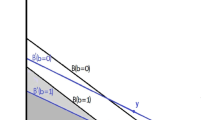Abstract
The aim of the present paper is twofold. First, after a brief introduction to the habit formation and addiction to a consumption good we illustrate that consumption may end up in persistent oscillations even within an intertemporal concave utility maximization framework. Thus, persistent “binges” are consistent with rational choice theory. Second, a time-discrete model of habit formation is analysed. We assume that addictive behaviour is damped by a threshold which adapts itself to the habit. Numerical results are presented suggesting that addictive agents behaving accordingly will exhibit chaotic consumption patterns.
This research was partly supported by the Austrian Science Foundation under contract No. P 7783-PHY
Preview
Unable to display preview. Download preview PDF.
Similar content being viewed by others
References
BECKER, G.S. and MURPHY, K.M. (1988), “A theory of rational addiction”, Journal of Political Economy 96, 675 - 700.
BOYER, M. (1978), “A habit forming optimal growth model”, International Economic Review 19, 585 - 609.
BOYER, M. (1983), “Rational demand and expenditures patterns under habit formation”, Journal of Economic Theory 31, 27 - 53.
DEVANEY, P.L. (1989), An Introduction to Chaotic Dynamical Systems, Addison-Wesley, Redwood City, CA.
DOCKNER, E.J. and FEICHTINGER, G. (1991), “On the optimality of limit cycles in dynamic economic systems”, Journal of Economics, 31–50.
DOCKNER, E.J. and FEICHTINGER, G. (1989), “Cyclical consumption patterns and rational addiction”, Forschungsbericht Nr. 120, Institut fur Okonometrie, Operations Research und Systemtheorie, Technische Universitat Wien, forthcoming in American Economic Review.
FEICHTINGER, G. (1992), “Rational addictive cycles (‘binges’) under a budget constraint”, Optimal Control Applications and Methods 13.
FEICHTINGER, G. and HARTL, R. F. (1986), “Optimale Kontrolleokonomischer Prozesse. Anwendungen des Maximumprinzips in den Wirtschaftswissenschaften”, de Gryuter, Berlin.
FEICHTINGER, G., HEROLD, W.and ZINNER, P. (1992), “Habit formation with threshold adjustment”, Forschungsbericht Nr. 140, Institut für Ökonometrie, Operations Research und Systemtheorie, Technische Universität Wien.
FEICHTINGER, G., HOMMES, C. H. and HEROLD, W. (1992), “Chaos in a simple deterministic queueing system”, Forschungsbericht Nr. 148, Institut für Ökonometrie, Operations Research und Systemtheorie, Technische Universität Wien.
HOMMES, C. H. (1991), Chaotic Dynamics in Economic Models: Some Simple Case Studies, Walters-Noordhoff, Groningen.
HOMMES, C. H. and FEICHTINGER, G. (1991), “How addiction implies binges and chaos”, Working paper, Vienna University of Technology, preliminary version.
IANNACONE, L. R. (1986), “Addiction and satiation”, Economics Letters 21, 95 - 99.
LORENZ, H.-W. (1989), “Nonlinear dynamical economics and chaotic motion”, Lecture Notes in Economics and Mathematical Systems 334, Springer, Berlin.
Léonard, D. (1989), “Market behaviour of rational addicts”, Journal of Economic Psychology 10, 117 - 144.
MEDIO, A. and GALLO, G. (1989), “Dynamical System Analysis-Software, Theory and Application to Economics”, Technical Report, University of Venice.
POLLAK, R.A. (1970), “Habit formation and dynamic demand functions”, Journal of Political Economy 78, 745 - 763.
POLLAK, R.A. (1976), “Habit formation and long-run utility functions”, Journal of Economic Theory 13, 272 - 297.
RYDER, H.E. and HEAL, G.M. (1973), “Optimal growth with intertemporally dependent preferences”, Review of Economic Studies 40, 1 - 33.
SCHAFFER, W.M. et al. (1988), “Dynamical Software: User’s Manual and Introduction to Chaotic Systems”, Dynamical Systems, Inc, Tucson, Arizona.
STIGLER, G.J. and BECKER, G.S. (1977), “De gustibus non est disputandum”, American Economic Review 67, 76 - 90.
WIGGINS, S. (1990), Introduction to Applied Nonlinear Dynamical: Systems and Chaos, Springer, New York.
WIRL, F. and FEICHTINGER, G. (1992), “Persistent cyclical consumption: variations on the Becker-Murphy model on addiction”, Working paper, Vienna University of Technology.
Author information
Authors and Affiliations
Editor information
Editors and Affiliations
Rights and permissions
Copyright information
© 1993 Springer-Verlag Berlin · Heidelberg
About this chapter
Cite this chapter
Feichtinger, G. (1993). Strange Addictive Behaviour: Periodic and Chaotic Binges. In: Diewert, W.E., Spremann, K., Stehling, F. (eds) Mathematical Modelling in Economics. Springer, Berlin, Heidelberg. https://doi.org/10.1007/978-3-642-78508-5_15
Download citation
DOI: https://doi.org/10.1007/978-3-642-78508-5_15
Publisher Name: Springer, Berlin, Heidelberg
Print ISBN: 978-3-642-78510-8
Online ISBN: 978-3-642-78508-5
eBook Packages: Springer Book Archive




